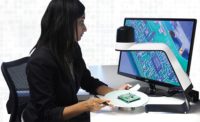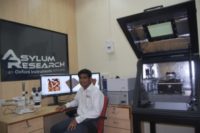With the help of microscopy and imaging technologies, as well as automation, manufacturing is making great strides toward more advanced and efficient processes for building bigger and better things.
According to Product Applications Manager, Robert Bellinger of Olympus, some of the current trends in manufacturing include microscopy techniques and technologies focused on imaging. “Within the Americas, I have noticed more of a focus on advanced imaging techniques,” he says. “Sought after features include higher resolution capabilities into the nanometer detection and imaging of more advanced structures using IR wavelengths. Though these trends are more aligned to the research and development part of the process than on the production line.”
And automation has been a prevalent part of this trend, particularly across the most common microscopy platforms. “I have seen more demand for automation in inspection routines to help reduce the amount of time to inspect either larger samples or multiple samples,” Robert says. “More automated systems such as the DSX digital microscope or fully motorized systems on either the BX or MX microscope platforms have lent themselves well to these demands.”
According to Robert, another upward trend is occurring due to stricter standards. “Cleanliness requirements within the manufacturing and aerospace markets have also been increasing. Olympus’ CIX™ cleanliness inspector system has been in high demand for customers focused on critical cleanliness inspection for product manufacturing.”
As is true of just about every aspect of any business, customers need to have a thorough knowledge of their products and applications before adopting microscopy into their operations. “Customers should understand what imaging techniques will work best on their products and samples,” Robert advises. “Understanding what measurements or detections they wish to make helps determine the level of microscope and level of automation that is required as well.”
And just like the expectation of cleanliness of the manufacturing and aerospace markets he mentioned above, Robert underlines that new microscopy users need to understand the demands they will place on their microscopy systems. “For manufacturing processes, the customer would need to know the demands of throughput required for the microscope inspection. Some systems can lend themselves well to high throughput, but some others require more operator involvement to perform the imaging technique or measurements.”
“I always describe microscopy as an integral part of almost all industry,” says Robert. “Over the years, I have always been amazed that microscopes lend themselves to almost any manufacturing or development process. Almost everything we interact with, utilize, eat from, drive, control, or rely on for any process has been inspected in one form or another by microscopy. Product requirements demand higher performance now, and imaging at microscopic levels is deemed necessary to meet requirements.”
However, for all their versatility and performance, microscopy customers need to keep one thing in mind. “The biggest misconception I see lately is that microscopes have even more abilities than they do,” said Robert. “It seems customers would like to have even more resolution, magnification, and automation than is currently possible. This just underscores the demand for high requirements spurring on modern production and product development. It’s pushing microscope development to new directions, such as fully motorized digital microscopes.”




